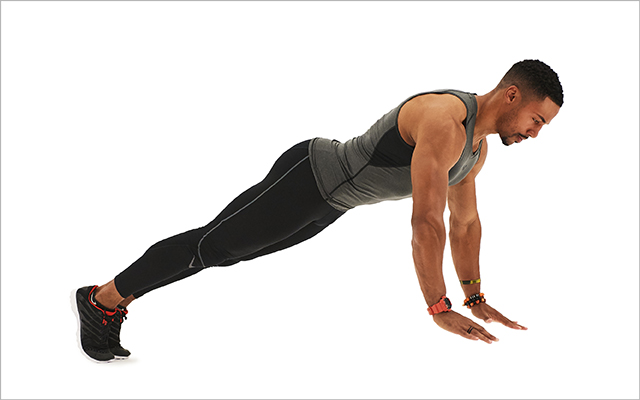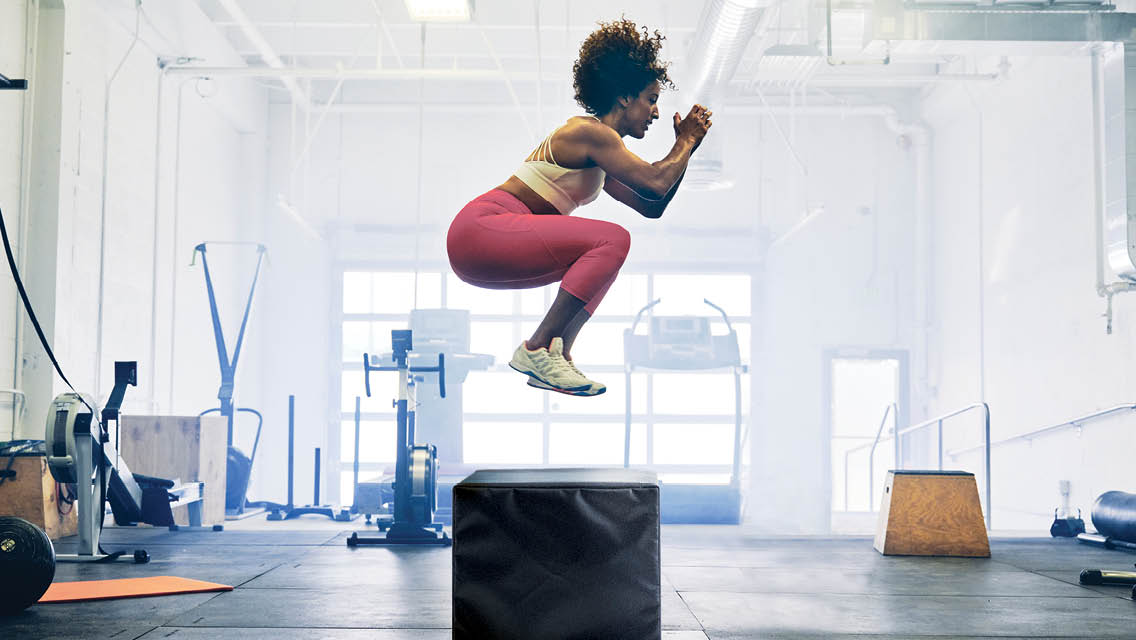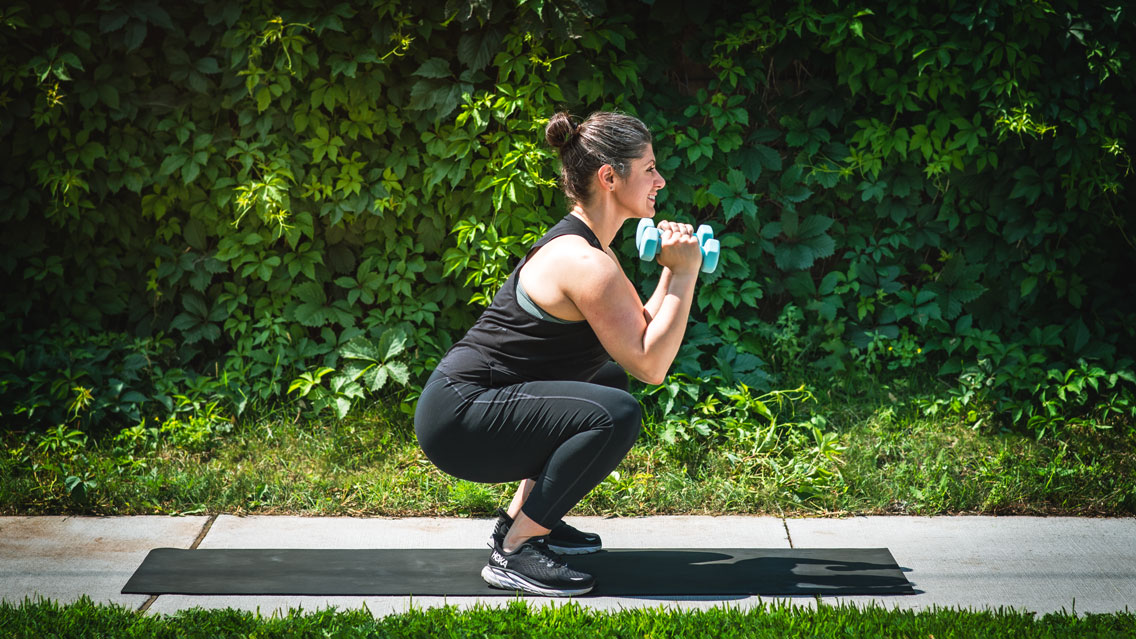Shortcuts to the following plyometric moves:
Jump Lunges | Skaters | Rotational Wall Slams | Frog Hops | Plyo Pushups
Hopscotch, jump rope, games of tag, and dodgeball — remember how fun and effortless it was to jump and sprint when you were a kid? If your quick, explosive movements are limited these days to leaping the occasional puddle or dashing for the bus, you’ve probably lost some of the spring in your step — and are missing out on some major, age-defying benefits of moving fast.
Enter plyometrics.
“Plyometrics” refers to the rapid transition of muscles from stretching (think lowering down into a squat) to contracting (exploding into a jump). Almost any movement can be performed plyometrically, says David Freeman, NASM-PES, OPEX CCP, National Manager of Alpha Training at Life Time. The key is to move well and fast — really fast.
The Soviet trainers who originally defined plyometrics dictated a stretch–contract transition of less than two-tenths of a second; more than that and the plyometric engagement would be lost. While you don’t have to pull out the stopwatch, you do have to be quick to reap the rewards.
Plyo training improves strength, acceleration, and explosive power. The carryover to sports like basketball and tennis may seem obvious, but you don’t have to be an athlete to benefit from better agility, power, and reaction time. “The more you practice these types of movements, the better you are able to naturally react in everyday life,” Freeman says.
Studies have proven that plyometrics have a positive effect on bone density; in some cases, they have even been shown to help prevent injury in athletes.
Most plyo movements are full-body and recruit a large number of muscle fibers, which means they quickly drive up your heart rate, boost your metabolism, and let you accomplish a large volume of work in a short period of time, Freeman says. This makes them popular for HIIT (high-intensity interval training), boot camps, and programs like Life Time’s Alpha Training.
Plyo moves are often high-impact and place significant stress on the joints as well as pressure on the pelvic floor. Movements can be modified, but some people may do best steering clear of plyometrics. If you are not sure whether plyo training is appropriate for you, consult your physician or a fitness professional.
For healthy individuals, Freeman advises first building a base of at least three months of resistance training, focusing on strength and stability and paying extra attention to your glutes and core muscles. Before performing a plyometric version of an exercise, make sure that you can first perform its basic movement pattern (squat, lunge, bend, push, pull, twist, or run) safely and efficiently.
The Workout
This circuit, designed and demonstrated by Life Time’s David Freeman, features five plyometric exercises in a HIIT format. Perform all the moves back to back, completing 20 seconds of each exercise, followed by 20 seconds of rest. Between rounds, rest for 90 seconds to two minutes, for a total of three to four rounds.
Freeman recommends doing this workout no more than twice a week, allowing at least 48 hours of recovery between sessions.
Make sure you can perform the Make It Easier version with good form before attempting an exercise’s full progression.
Exercise Space and Equipment
For this workout, you will need a solid, shock-absorbing surface (such as a rubber floor or grassy area), a moderately heavy medicine ball, and a strong wall. Note that all the moves can be modified to be equipment-free.
Warm-up
Perform about 10 minutes of dynamic, full-body movement before beginning this workout.
Jump Lunges
Why We Love It: Builds explosive power through your lower body and strengthens each leg individually.
How to Do It:
- Stand in a split stance, right leg forward, with both knees softly bent. Keep your core engaged and your spine neutral; weight is balanced on both feet.
- Bend both knees to lower into a split squat, making sure that your front knee does not cross over your toes.
- When your back knee is about an inch from the ground, exhale and then immediately push off your front foot as you lift your back foot to jump. In midair, switch your feet so that your left leg is now in front and your right leg is behind you.
- Land softly on the ball of your front foot, sinking back into your heel; then let your back foot touch down as you lower into a split squat. Inhale.
- Alternate sides for the duration of the interval.
Make It Easier: Perform alternating reverse lunges without leaving the ground, transitioning quickly from one leg to the other.
Skaters
Why We Love It: Helps build balance and coordination; evens out left–right imbalances in the lower body.
How to Do It:
- Start in an athletic stance, with feet at hip width, core engaged, and knees slightly bent.
- Push off your right foot to hop to your left and land gently on the ball of your left foot. Let the left heel come down as you bring your right foot behind your left ankle.
- Quickly push off your left foot to hop to your right and land on the ball of your right foot. Let the right heel come down as you bring your left foot behind your right ankle.
- Keep your knees bent and feet facing forward with each landing. Let your arms cross your body as you jump.
- Continue alternating sides for the duration of the interval.
Make It Easier: Slow down the movement to maintain soft, controlled landings, or step side to side without the jump.
Rotational Wall Slams
Why We Love It: Builds powerful trunk rotation, engages all the major muscles of your core, and improves motor control and coordination.
How to Do It:
- Stand with the left side of your body toward a wall, about 5 feet away, holding a medicine ball. Start in an athletic stance, with feet at hip width and knees slightly bent.
- Inhale as you rotate your torso away from the wall, moving the ball toward the outside of your right hip. Shift your weight onto your right foot, and allow your left foot to pivot.
- Exhale as you rotate to your left, shifting weight to your left foot and slamming the ball against the wall.
- On an inhale, catch the ball as it bounces back to you and immediately rotate toward your right, shifting onto your right foot.
- Repeat for the duration of the interval. Then switch sides.
Make It Easier: Perform this exercise without a ball.
Frog Hops
Why We Love It: Strengthens the quadriceps and adductors, improves lower-body explosiveness, and challenges your cardiovascular system.
How to Do It:
- Stand with feet slightly wider than hips and toes turned out slightly. Inhale as you lower down into a squat, making sure not to tuck your tailbone (don’t round your lower back), and touch the ground in front of you with both hands.
- Exhale and drive through the balls of your feet to push off the ground and jump forward, extending your knees and hips.
- Inhale as you land softly on the balls of your feet with knees bent, and sink back down into a squat, again placing your hands on the ground in front of you.
- Repeat for the duration of the interval.
Make It Easier: Reach only as low as you are able without tucking your tailbone. Stand up between repetitions if necessary.
Plyo Pushups
Why We Love It: Builds explosiveness in the upper body, which translates into power for sports such as basketball, baseball, and tennis.
How to Do It:
- Start in a plank position with your hands directly under your shoulders. Keep your feet together and squeeze your glutes.
- Inhale as you bend your elbows, pointing them slightly backward and to the sides, and lower your body toward the floor.
- Just as your chest is about to touch the floor, exhale and immediately push up as fast as possible, lifting your hands off the floor when your arms straighten completely.
- Inhale as you catch your body by returning your hands to the floor before your chest touches down.
- Repeat for the duration of the interval.
Make It Easier: Place your hands on an elevated surface, such as a bench. If your hands don’t come off the bench, that’s OK. Focus on lowering down slowly and quickly pressing up to the top of the pushup.
Bonus Plyo Moves
Substitute these moves for any of the ones above — or tack them on to make your workout more intense. Just remember: Even if you extend the duration or difficulty of the workout, the point is to perform the moves with purpose and swiftness. Focus on form and speedy transitions.
Reaching Reverse Lunge With Hop
Why We Love It: This move combines single-leg stability, control, and power, making it a great move for runners and anyone else whose sport demands taking off and landing on one foot.
How to Do It
- Stand with feet at hip width. Inhale as you step your right foot backward into a lunge, keeping your weight in your left foot. Right knee should be about an inch off the ground at the bottom of the lunge. Tap the ground next to your left foot with your right fingertips.
- Exhale as you drive through your left heel and extend through your left leg to jump off the ground, pushing off with the ball of your foot. As you jump, bring your right knee up to chest height.
- Land softly on the ball of your left foot, then sink back into your left heel as you step the right foot backward again into a lunge.
- Repeat for the duration of the interval. Switch sides.
Modification: Start by performing this move without the hop, then add the hop when you feel stable, bringing your knee just to hip height.
Star Jumps
Why We Love It: This seemingly basic move challenges coordination while building lower-body explosiveness.
How to Do It
- Stand with feet and knees together and arms together in front of your chest and crouch down into a squat.
- Exhale and drive through the balls of your feet to push off the ground, extending your knees and hips and as you bring your feet wide and land softly on the balls of your feet. Simultaneously bring your arms into a “Y” position overhead.
- Inhale as you simultaneously bring your arms back in toward your chest and push your hips back and bend your knees to descend into a squat.
- Repeat for the duration of the interval.
Modification: Perform just the first part of the movement, jumping into the “Y” position, then reset in the squat position before starting the next repetition.
Wall Ball Toss
Why We Love It: This move trains coordination of your upper and lower body and improves your ability to generate power through your shoulders, core, and hips.
How to Do It
- Stand with feet at hip width, about an arm’s distance away from a wall. Hold a medicine ball or other heavy ball with two hands at chest level.
- Inhale as you push your hips back and bend your knees to lower into a squat. Maintain a vertical torso and keep the ball at your chest.
- Exhale as you quickly rise out of the squat, driving your hips forward and extending your legs.
- Just before you reach the top of the movement, throw the ball upward and with a slight forward arc so that it hits the wall, about 4 to 5 feet higher than your head.
- Immediately drop down into a squat on an inhale and prepare to catch the ball as it deflects off the wall. Catch the ball at chest height, just before you reach the lowest point in your squat.
- Repeat for the duration of the interval.
Modification: Start with a light ball until you become comfortable with the movement. (See, “The Wall Ball Toss” for more detailed instructions.)
Burpee Broad Jump
Why We Love It: This full-body move quickly elevates your heart rate while incorporating the functional task of getting up and down from the ground. The forward jump and landing challenges coordination.
How to Do It
- Stand with feet at hip width, gazing forward.
- Push your hips back and bend your knees to place your hands on the ground in front of you.
- Inhale as you jump your feet back into a plank position with feet wide, keeping tension through your core.
- Exhale as you jump your feet forward to your hands.
- Lift your hands off the ground and inhale as you swing your arms backward while in a deep squat.
- Exhale as you swing your arms forward and jump forward, landing softly on the balls of your feet with knees bent.
- Repeat for the duration of the interval.
Modification: Take out the forward jump. If necessary for mobility reasons, place hands on a stable, elevated surface, making sure to keep shoulders directly over wrists.




This Post Has 3 Comments
Love the straightforward descriptions and the easy-to-understand background knowledge of plyometrics and it’s benefits. This is the twist I need to add to my workout routines. Invaluable!
Jumping—NO.! What are the other options for athletes with hip/feet/knee issues?
Thank you for this! Invaluable! Simple, straight forward!